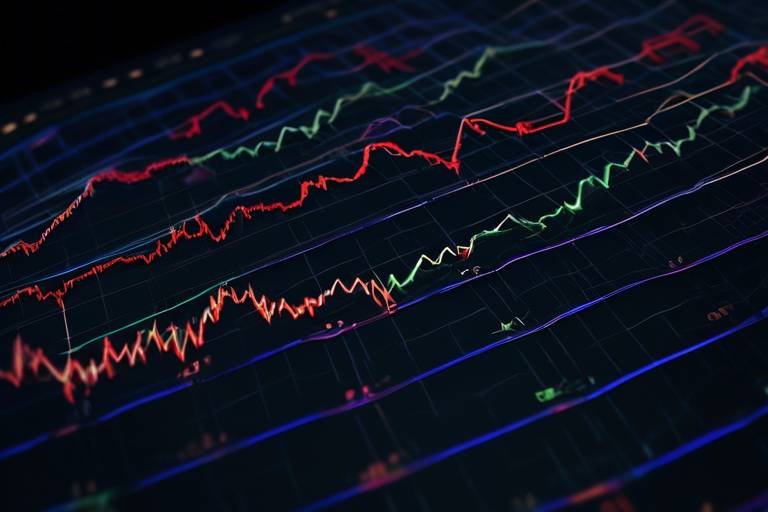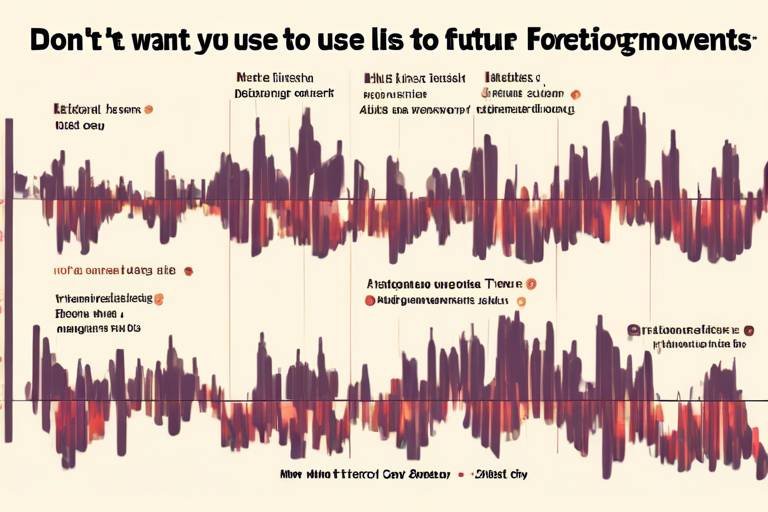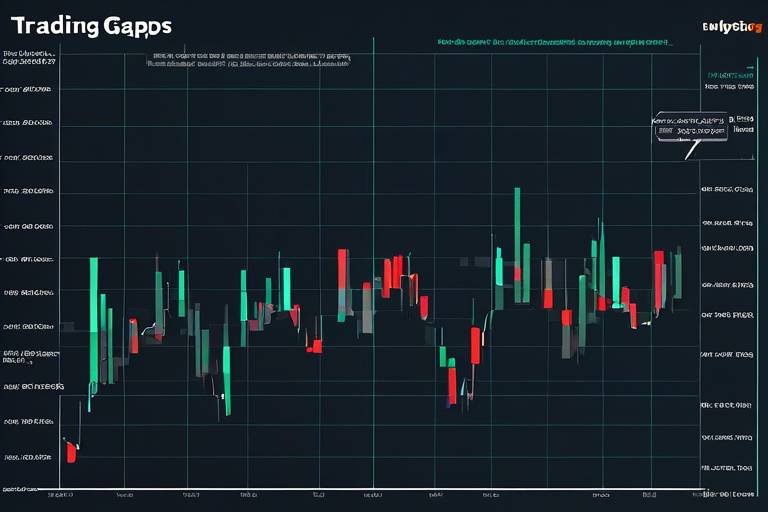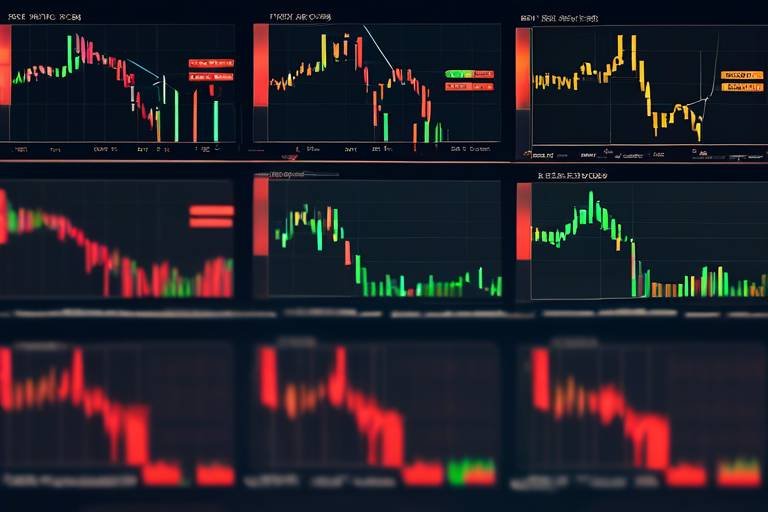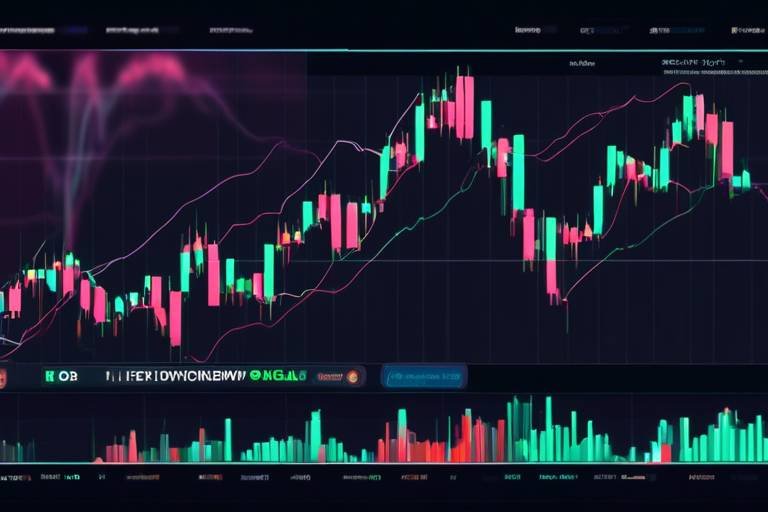Understanding the Basics of Technical Indicators in Crypto
In the fast-paced world of cryptocurrency trading, making informed decisions can feel like navigating a maze. This is where technical indicators come into play. They act as your guiding compass, helping you interpret market trends and price movements. But what exactly are these indicators, and why are they so crucial for traders, both seasoned and new? Let’s dive into the fundamentals of technical indicators, unravel their significance, and discover how they can enhance your trading strategies.
Technical indicators are essentially mathematical calculations derived from historical price and volume data. Think of them as sophisticated tools that help traders forecast future price movements by analyzing past market behavior. By examining these indicators, traders can identify trends, understand market conditions, and make more informed decisions. They’re like a crystal ball that provides insights into potential price action, allowing traders to navigate the often unpredictable waters of cryptocurrency markets.
There are numerous types of technical indicators, each serving a specific purpose in market analysis. These can be broadly categorized into four main types:
- Trend Indicators: These help traders identify the direction of the market.
- Momentum Indicators: These assess the speed of price movements.
- Volatility Indicators: These measure the degree of price fluctuations.
- Volume Indicators: These analyze the amount of trading activity.
Each type of indicator plays a unique role in understanding market behavior, and using them effectively can significantly enhance trading strategies.
When it comes to trend indicators, they are your best friends in identifying whether the market is moving upwards (bullish) or downwards (bearish). Two prime examples of trend indicators are Moving Averages and the Average Directional Index (ADX). These tools provide valuable insights into market trends and help traders make strategic decisions.
Moving Averages smooth out price data over a specific period, allowing traders to spot trends more easily. They are crucial for determining entry and exit points in trading strategies. Imagine them as a gentle breeze that clears the fog, revealing the path ahead. By analyzing moving averages, traders can identify whether to buy or sell based on historical price trends.
The ADX measures the strength of a trend, giving traders a clearer picture of market dynamics. It helps assess whether to enter a trade based on the strength of the trend rather than its direction. Think of it as a gauge that tells you how 'strong' the wind is blowing, helping you decide whether to set sail or stay anchored.
Momentum indicators are all about the speed of price movements. They indicate potential reversals or continuations in the market. Popular momentum indicators include the Relative Strength Index (RSI) and the Stochastic Oscillator. These indicators serve as a pulse check on the market, helping traders gauge whether a cryptocurrency is overbought or oversold.
Using technical indicators effectively requires a solid understanding of their signals and how they fit into your overall trading strategy. It’s essential to combine multiple indicators to gain a comprehensive view of market conditions. This multi-faceted approach can significantly enhance decision-making and improve trading outcomes.
Traders often find that combining different types of indicators provides a richer analysis of the market. For instance, using a trend indicator alongside a momentum indicator can help confirm trading signals and reduce the likelihood of false positives. It’s like having a team of experts collaborating to provide a well-rounded perspective on market movements.
Backtesting is a crucial step in developing a winning trading strategy. It involves applying technical indicators to historical data to evaluate the effectiveness of your approach. By analyzing past performance, traders can refine their strategies and increase their chances of success in live trading. Think of it as rehearsing for a performance; the more you practice, the better you’ll be when the spotlight is on you!
Even seasoned traders can fall into traps when using technical indicators. Awareness of these pitfalls can significantly improve trading performance. Here are some common mistakes to avoid:
- Over-Reliance on Indicators: Relying solely on technical indicators without considering market fundamentals can lead to poor trading decisions.
- Ignoring Market News: Market news and events can significantly impact prices. Ignoring these factors while relying on technical indicators may result in unexpected losses.
Understanding technical indicators is essential for successful crypto trading. By learning how to use them effectively and avoiding common mistakes, traders can enhance their strategies and improve their chances of success. Remember, in the world of crypto, knowledge is power, and technical indicators are your tools to harness that power.
1. What are the most popular technical indicators used in crypto trading?
Some of the most popular technical indicators include Moving Averages, Relative Strength Index (RSI), and MACD (Moving Average Convergence Divergence). Each of these indicators provides unique insights into market conditions.
2. How can I start using technical indicators in my trading?
Begin by familiarizing yourself with different types of indicators and how they work. You can practice using them on demo trading platforms before applying them in live trades.
3. Is it advisable to rely solely on technical indicators?
No, while technical indicators are valuable tools, it's essential to consider market fundamentals and news events to make well-rounded trading decisions.

What Are Technical Indicators?
Technical indicators are essential tools in the world of cryptocurrency trading. They are mathematical calculations that derive their values from historical price and volume data. By analyzing these indicators, traders can forecast future price movements and make informed decisions. Imagine trying to navigate a dark forest without a map; technical indicators serve as that guiding light, illuminating the path ahead based on past experiences.
The significance of technical indicators cannot be overstated. They help traders identify trends, assess market conditions, and recognize potential entry and exit points. This is particularly vital in the highly volatile crypto market, where prices can swing dramatically in a matter of minutes. By using these indicators, traders can gain a clearer picture of market dynamics, allowing them to react swiftly and strategically.
There are various types of technical indicators, each serving a unique purpose. Below are some of the main categories:
- Trend Indicators: These indicators help traders identify the overall direction of the market.
- Momentum Indicators: These assess the speed of price movements, indicating potential reversals or continuations.
- Volatility Indicators: These measure the rate at which the price of an asset increases or decreases.
- Volume Indicators: These provide insights into the strength of a price movement based on trading volume.
By understanding these categories, traders can select the most appropriate indicators for their trading strategies. For example, if a trader is focused on identifying market trends, they might prioritize trend indicators like Moving Averages or the Average Directional Index (ADX). On the other hand, if they're more interested in the speed of price movements, they might look at momentum indicators like the Relative Strength Index (RSI).
In summary, technical indicators are invaluable assets for traders in the cryptocurrency market. They not only provide insights into past performance but also equip traders with the necessary tools to anticipate future price movements. As you delve deeper into the world of crypto trading, mastering these indicators will undoubtedly enhance your trading strategies and decision-making processes.

Types of Technical Indicators
When it comes to navigating the volatile waters of cryptocurrency trading, understanding the different is crucial. These indicators serve as the compass for traders, guiding them through the often turbulent market conditions. Broadly, technical indicators can be categorized into four main types: trend indicators, momentum indicators, volatility indicators, and volume indicators. Each category plays a unique role in helping traders analyze market behavior and price movements.
Trend indicators are like the wind in your sails, showing you the direction in which the market is moving. For instance, Moving Averages smooth out price fluctuations over a specified period, allowing traders to identify whether the market is trending upwards or downwards. Another popular trend indicator is the Average Directional Index (ADX), which measures the strength of a trend, helping traders decide whether they should enter a trade based on how strong that trend is.
On the other hand, momentum indicators assess the speed of price movements, acting as a pulse check for the market. Indicators like the Relative Strength Index (RSI) and the Stochastic Oscillator fall into this category. They help traders identify potential reversals or continuations in price movements. For example, if the RSI indicates that a cryptocurrency is overbought, it may suggest a price correction is imminent.
Then we have volatility indicators, which measure the degree of variation in trading prices. These indicators are crucial for understanding market risk. The Average True Range (ATR) is a commonly used volatility indicator that helps traders gauge market volatility and adjust their strategies accordingly. Lastly, volume indicators provide insights into the amount of trading activity for a particular asset. High trading volume often indicates strong interest and can validate price movements, while low volume can signal potential reversals.
| Type of Indicator | Description | Examples |
|---|---|---|
| Trend Indicators | Indicate the direction of the market trend. | Moving Averages, ADX |
| Momentum Indicators | Assess the speed of price movements. | RSI, Stochastic Oscillator |
| Volatility Indicators | Measure market volatility and risk. | ATR |
| Volume Indicators | Indicate the amount of trading activity. | On-Balance Volume (OBV) |
In summary, understanding these types of technical indicators can significantly enhance your trading strategies. By incorporating a mix of trend, momentum, volatility, and volume indicators, traders can gain a more comprehensive view of the market, ultimately leading to more informed trading decisions.

Trend Indicators
When it comes to navigating the turbulent waters of cryptocurrency trading, are like a compass guiding you through the fog. They help traders pinpoint the direction of the market, whether it's soaring upwards in a bullish trend or plummeting downwards in a bearish one. Understanding how to read these indicators can significantly enhance your trading strategy, making it a crucial skill for both novices and seasoned traders alike.
Two of the most popular trend indicators are Moving Averages and the Average Directional Index (ADX). Each serves a unique purpose, but together they can provide a well-rounded view of market conditions. Let’s dive deeper into these indicators and see how they can be utilized effectively.
Moving Averages are essential in smoothing out price data over a specific period, helping traders identify the underlying trend without the noise of daily price fluctuations. Imagine you're looking at a rollercoaster; while the ride may have its ups and downs, the moving average helps you see the overall trajectory. There are two main types of moving averages:
- SMA (Simple Moving Average): This is calculated by adding the closing prices over a certain number of periods and then dividing that sum by the number of periods. It provides a straightforward view of the average price over time.
- EMA (Exponential Moving Average): This gives more weight to recent prices, making it more responsive to new information. It's like having a friend who always keeps you updated on the latest gossip!
Traders often use moving averages to determine entry and exit points. For example, if the price crosses above the moving average, it might signal a good time to buy, while a cross below could indicate a sell signal. However, it's essential to remember that no indicator is foolproof; they work best when combined with other tools and analysis methods.
The ADX is another valuable trend indicator that measures the strength of a trend, rather than its direction. Think of it as a strength meter for trends. It ranges from 0 to 100, with values above 20 indicating a strong trend and values below suggesting a weak trend. This can be particularly useful for traders trying to determine whether to enter a trade based on the trend's strength.
For example, if the ADX is above 25, it suggests that the trend is strong enough to warrant a trading decision. Conversely, if it’s below 20, it might be wise to sit on the sidelines. By using the ADX in conjunction with other indicators, traders can refine their strategies and make more informed decisions.
In summary, trend indicators like Moving Averages and the ADX are invaluable tools in the arsenal of any crypto trader. They not only help identify the direction of the market but also the strength of those trends, allowing traders to make more informed decisions. As you continue to explore the world of crypto trading, remember that mastering these indicators can be the key to unlocking your trading potential.
Q1: What are the best trend indicators for beginners?
A1: For beginners, Moving Averages and the ADX are excellent starting points. They are relatively easy to understand and can provide clear signals for trading decisions.
Q2: Can I rely solely on trend indicators for trading?
A2: While trend indicators are helpful, it's essential to combine them with other forms of analysis, such as fundamental analysis and market news, to make well-rounded trading decisions.
Q3: How can I improve my understanding of trend indicators?
A3: Practice is key! Use demo accounts to experiment with different indicators and backtest strategies to see how they perform under various market conditions.

Moving Averages
Moving Averages are one of the most widely used technical indicators in the world of cryptocurrency trading. They serve as a powerful tool for smoothing out price data over a specific time period, allowing traders to identify trends more clearly. Imagine trying to read a book while someone constantly flips the pages; it would be nearly impossible to grasp the story. In the same way, Moving Averages help eliminate the 'noise' from price movements, making it easier to see the underlying trend.
There are two primary types of Moving Averages that traders commonly use: the Simple Moving Average (SMA) and the Exponential Moving Average (EMA). Each of these averages has its unique characteristics and applications:
- Simple Moving Average (SMA): This is calculated by averaging the closing prices over a specified number of periods. For example, a 50-day SMA takes the closing prices of the last 50 days and divides them by 50. This indicator is great for identifying longer-term trends.
- Exponential Moving Average (EMA): Unlike the SMA, the EMA gives more weight to recent prices, making it more responsive to new information. Traders often prefer the EMA for shorter time frames since it reacts more quickly to price changes.
Using Moving Averages effectively can significantly enhance your trading strategy. One common approach is to look for crossovers. A bullish crossover occurs when a shorter-term Moving Average crosses above a longer-term Moving Average, suggesting a potential upward trend. Conversely, a bearish crossover happens when the shorter-term Moving Average crosses below the longer-term Moving Average, indicating a possible downward trend.
| Type of Moving Average | Characteristics | Best Used For |
|---|---|---|
| Simple Moving Average (SMA) | Calculates average prices over a set period, smoothing out fluctuations. | Identifying long-term trends. |
| Exponential Moving Average (EMA) | Gives more weight to recent prices, reacting faster to price changes. | Short-term trading strategies. |
Incorporating Moving Averages into your trading strategy can help you make more informed decisions. However, it's essential to remember that no indicator is foolproof. Always consider other factors, such as market conditions and news events, when making trading decisions. Just as a seasoned chef combines various ingredients to create a delicious dish, successful traders blend multiple indicators and analyses to achieve the best results.
- What is the best Moving Average to use? The best Moving Average often depends on your trading style. Short-term traders may prefer the EMA, while long-term investors might lean towards the SMA.
- How do I set up Moving Averages on my trading platform? Most trading platforms allow you to customize indicators. Look for the 'indicators' section and select Moving Averages, then adjust the time period according to your strategy.
- Can I use Moving Averages for all cryptocurrencies? Yes, Moving Averages can be applied to any cryptocurrency, but the effectiveness may vary based on market volatility and trading volume.

Average Directional Index (ADX)
The is a powerful tool in the arsenal of a trader, designed to measure the strength of a trend rather than its direction. Unlike many indicators that simply indicate whether the market is moving up or down, the ADX provides insights into how strong that movement is. This means that even if the market is trending upwards, if the ADX is low, it suggests that the trend lacks strength and could reverse at any moment.
Understanding the ADX can be likened to feeling the pulse of a market. Just as a doctor checks a patient's pulse to gauge their health, traders use the ADX to assess the vitality of market trends. The ADX is typically plotted on a scale from 0 to 100, with readings below 20 indicating a weak trend and readings above 40 suggesting a strong trend. This makes it a crucial indicator for traders looking to make informed decisions about when to enter or exit trades.
To effectively utilize the ADX, traders often look for specific thresholds. For instance, when the ADX rises above 25, it signals the beginning of a strong trend, whether it be bullish or bearish. Conversely, if the ADX falls below 20, it suggests that the market is consolidating, and traders might want to exercise caution. Here’s a quick breakdown of ADX readings:
| ADX Value | Interpretation |
|---|---|
| 0 - 20 | Weak trend or sideways movement |
| 20 - 25 | Possible trend beginning |
| 25 - 40 | Strong trend |
| 40 - 60 | Very strong trend |
| 60+ | Extreme trend strength (potential reversal) |
Moreover, the ADX can be used in conjunction with two other lines, known as the +DI (Positive Directional Indicator) and -DI (Negative Directional Indicator). These indicators help traders determine the direction of the trend. For example, if the +DI is above the -DI and the ADX is rising, it indicates a strong bullish trend. Conversely, if the -DI is above the +DI, it suggests a strong bearish trend. This combination allows traders to not only gauge trend strength but also make informed decisions about the direction of their trades.
In summary, the ADX is an invaluable indicator for traders seeking to understand market dynamics. By focusing on trend strength rather than direction, it helps to filter out noise and identify genuine trading opportunities. Whether you're a novice or an experienced trader, incorporating the ADX into your trading strategy can provide a clearer picture of market conditions and improve your overall trading performance.
- What is the ideal ADX level for trading?
The ideal ADX level varies among traders, but generally, an ADX above 25 is considered a strong trend signal. - Can I use ADX alone for trading decisions?
While ADX is useful, it is best used in conjunction with other indicators like +DI and -DI for a more comprehensive analysis. - How often should I check the ADX?
It depends on your trading strategy. Day traders may check it frequently, while swing traders might look at it daily or weekly.

Momentum Indicators
Momentum indicators are essential tools in the world of cryptocurrency trading, acting like a compass that helps traders navigate the often tumultuous seas of market fluctuations. These indicators measure the speed and strength of price movements, providing insights into potential reversals or continuations of trends. Think of them as the heartbeat of the market; when the momentum is strong, it indicates that the price is likely to continue in the same direction, while a weakening momentum might suggest an impending change.
Two of the most popular momentum indicators are the Relative Strength Index (RSI) and the Stochastic Oscillator. Let's delve deeper into each of these tools:
| Indicator | Description | Usage |
|---|---|---|
| Relative Strength Index (RSI) | A momentum oscillator that measures the speed and change of price movements, typically ranging from 0 to 100. | Traders often look for readings above 70 to indicate overbought conditions and below 30 for oversold conditions. |
| Stochastic Oscillator | Compares a particular closing price of a cryptocurrency to a range of its prices over a certain period. | Values above 80 indicate overbought conditions, while values below 20 suggest oversold conditions. |
Using these momentum indicators effectively requires understanding their signals. For instance, the RSI can help traders identify potential reversal points. If the RSI is above 70, it might be time to consider selling, as the asset may be overbought. Conversely, if it drops below 30, it could be an opportunity to buy, indicating that the asset is oversold.
On the other hand, the Stochastic Oscillator provides insights into the closing price's position relative to its price range over a specific period. This can help traders determine whether an asset is overbought or oversold. By combining these indicators, traders can enhance their decision-making process, leading to more informed trading strategies.
However, it’s crucial to remember that momentum indicators are not foolproof. They should always be used in conjunction with other forms of analysis, such as trend indicators and fundamental analysis, to create a well-rounded trading strategy. After all, relying solely on one type of indicator can lead to missed opportunities or, worse, financial losses.
- What is the best momentum indicator for crypto trading? While there isn't a one-size-fits-all answer, the RSI and Stochastic Oscillator are widely used and can be effective when applied correctly.
- How do I know when to buy or sell using momentum indicators? Look for overbought or oversold signals. For example, an RSI above 70 might indicate a good selling opportunity, while below 30 could suggest a buying opportunity.
- Can I rely solely on momentum indicators? It’s not advisable to rely solely on momentum indicators. Combining them with other indicators and analysis methods is essential for a more comprehensive trading strategy.

How to Use Technical Indicators Effectively
Using technical indicators effectively is an art that combines understanding, strategy, and a bit of intuition. First and foremost, it's essential to grasp the signals that these indicators provide. Each indicator has its own unique way of interpreting market data, and recognizing these signals can help you make informed decisions. For instance, if you're using the Relative Strength Index (RSI), understanding when the market is overbought or oversold can be crucial in determining your next move.
One of the best practices in utilizing technical indicators is to integrate them into a comprehensive trading strategy. This means not just relying on one indicator to guide your decisions but combining multiple indicators to gain a more holistic view of market conditions. For example, you might use a trend indicator like the Moving Average alongside a momentum indicator like the Stochastic Oscillator. By doing this, you can confirm trends and identify potential reversals, enhancing your decision-making process.
Another critical aspect of using technical indicators is backtesting. This process involves applying your chosen indicators to historical price data to evaluate how well your trading strategies would have performed. It’s like taking your car for a test drive before buying it; you want to ensure that your strategy is sound and that it can withstand the test of time. Backtesting allows you to refine your approach, helping you to identify strengths and weaknesses in your strategy before you risk real capital.
Moreover, it's important to remember that technical indicators are not foolproof. They can sometimes give false signals, leading to potential losses. Therefore, it’s crucial to maintain a balanced perspective. Consider the market context—economic news, geopolitical events, and overall market sentiment can all have significant impacts on price movements. By integrating these elements into your analysis, you can better prepare yourself for the unpredictable nature of the crypto market.
In summary, using technical indicators effectively requires a blend of knowledge, strategy, and adaptability. By combining different indicators, backtesting your strategies, and staying aware of market conditions, you can significantly enhance your trading outcomes. Remember, trading is as much about psychology and discipline as it is about technical analysis, so keep your emotions in check and stick to your plan.
Q1: What are the most popular technical indicators for crypto trading?
A1: Some of the most popular technical indicators include the Moving Average, Relative Strength Index (RSI), Stochastic Oscillator, and Average Directional Index (ADX). Each serves a unique purpose in analyzing market behavior.
Q2: Can I rely solely on technical indicators for trading decisions?
A2: While technical indicators are valuable tools, relying solely on them can lead to poor decisions. It's essential to consider market fundamentals and news events alongside technical analysis.
Q3: How do I know which indicators to use?
A3: The choice of indicators depends on your trading style and strategy. Experiment with different indicators through backtesting to see which ones align best with your approach.
Q4: Is backtesting necessary for trading strategies?
A4: Yes, backtesting is crucial as it helps you evaluate the effectiveness of your strategies using historical data, allowing you to make informed adjustments before trading live.

Combining Indicators
When it comes to trading in the volatile world of cryptocurrency, the phrase "the whole is greater than the sum of its parts" couldn't be more applicable. By combining technical indicators, traders can create a more robust strategy that offers a clearer picture of market conditions. Think of it like mixing different colors to create a more vibrant hue; each indicator adds its own shade, enhancing the overall analysis.
For instance, using a trend indicator like the Moving Average alongside a momentum indicator like the Relative Strength Index (RSI) can yield powerful insights. The Moving Average helps you identify the direction of the market trend, while the RSI can indicate whether the market is overbought or oversold. This combination allows traders to not only see where the market is heading but also assess the strength of that movement.
Moreover, combining indicators can mitigate the risks associated with relying on a single signal. Each indicator has its own strengths and weaknesses, and by using them in conjunction, traders can cross-verify signals. For example, if both the Moving Average and the RSI suggest a potential buying opportunity, the confidence in that decision increases significantly.
However, it's important to remember that not all combinations are effective. Traders should focus on indicators that complement each other rather than those that provide redundant information. Here are a few combinations that work well together:
- Moving Average + RSI: Identifies trends and checks for overbought/oversold conditions.
- MACD + Stochastic Oscillator: Offers insights into momentum and trend reversals.
- Volume Indicators + Price Action: Confirms trends and potential breakouts.
Ultimately, the key to successfully combining indicators lies in backtesting and refining your strategy. By applying your chosen combinations to historical data, you can evaluate their effectiveness and make necessary adjustments. This process not only enhances your understanding of how these indicators interact but also builds your confidence in using them in live trading situations.
In conclusion, combining technical indicators is a powerful strategy that can significantly enhance your trading performance. By thoughtfully selecting and integrating different indicators, you can create a comprehensive trading plan that not only identifies potential opportunities but also minimizes risks. So, next time you analyze the market, remember to mix your indicators wisely for a more complete view!
Q: Can I use any combination of indicators?
A: While you can technically combine any indicators, it's best to choose those that complement each other and provide unique insights to avoid redundancy.
Q: How do I know if my indicator combination is effective?
A: Backtesting your combinations against historical data can provide insights into their effectiveness and help refine your trading strategy.
Q: Should I rely solely on technical indicators for trading decisions?
A: No, it's essential to consider market fundamentals and news events in conjunction with technical indicators for a more comprehensive trading approach.

Backtesting Strategies
Backtesting strategies is a crucial step for any trader looking to enhance their trading game. It involves applying technical indicators to historical data to see how a particular strategy would have performed in the past. Think of it as a dress rehearsal before the big performance—you're not just winging it on stage; you're practicing, refining, and preparing for success. By simulating trades based on past market conditions, traders can gain valuable insights into the effectiveness of their strategies without risking real capital.
To effectively backtest a strategy, you'll want to follow a structured approach. Here’s a simple breakdown:
- Select Your Indicators: Choose the technical indicators that align with your trading goals. This could be anything from Moving Averages to the Relative Strength Index (RSI).
- Define Your Strategy: Clearly outline your entry and exit points based on the indicators. For instance, you might decide to buy when the 50-day Moving Average crosses above the 200-day Moving Average.
- Use Historical Data: Gather historical price data for the asset you’re interested in. The more data you have, the better your analysis will be.
- Run the Backtest: Apply your strategy to the historical data and track the results. This will help you assess its profitability and risk factors.
- Analyze the Results: Look at key metrics such as win rate, average profit per trade, and maximum drawdown to evaluate the strategy's performance.
Now, while backtesting can provide a wealth of information, it's essential to remember that past performance is not always indicative of future results. Market conditions can change, and what worked yesterday might not work tomorrow. Therefore, it’s vital to approach backtesting with a critical eye, adjusting your strategies as needed based on new data and market trends.
Moreover, consider using backtesting software or platforms that can automate this process. Many trading platforms offer built-in tools for backtesting, allowing you to save time and focus more on refining your strategies. This can be especially beneficial for those who are new to trading or may not have the technical skills to analyze data manually.
In summary, backtesting strategies is a powerful tool in the arsenal of any trader. It allows you to test your theories, minimize risks, and ultimately, improve your trading performance. By taking the time to backtest, you’re not just gambling with your investments; you’re making informed decisions based on data and analysis.
- What is backtesting? Backtesting is the process of testing a trading strategy using historical data to determine its effectiveness.
- Why is backtesting important? It helps traders understand how a strategy would have performed in the past, allowing for informed decision-making in the future.
- Can I rely solely on backtesting results? No, while backtesting provides valuable insights, it's important to consider current market conditions and other factors.
- What tools can I use for backtesting? Many trading platforms offer backtesting tools, and there are also dedicated software programs available for this purpose.

Common Mistakes to Avoid
When diving into the world of cryptocurrency trading, it's easy to get swept away by the excitement and potential profits. However, many traders, both novice and experienced, often fall into common traps that can derail their trading success. One of the biggest pitfalls is the over-reliance on technical indicators. While these tools are invaluable for analyzing market trends, relying solely on them without considering the broader market context can lead to misguided decisions. For instance, a trader might see a bullish signal from an indicator but fail to recognize that significant negative news is affecting the market, which could lead to losses.
Another frequent mistake is ignoring market news and events. The cryptocurrency market is notoriously volatile, and external factors such as regulatory changes, technological advancements, or even social media trends can dramatically impact prices. For example, a major exchange hack can trigger a sell-off, rendering any technical analysis irrelevant. Therefore, staying updated with the latest news is crucial for making informed trading decisions.
Additionally, many traders tend to focus on a single indicator rather than employing a combination of tools. Each technical indicator provides a different perspective on market conditions, and using a variety of them can paint a clearer picture. For instance, combining momentum indicators like the Relative Strength Index (RSI) with trend indicators like Moving Averages can give traders a more comprehensive understanding of market dynamics.
Moreover, it's essential to avoid the trap of confirmation bias. This occurs when traders only seek out information that confirms their existing beliefs or positions. Instead, a successful trader should remain open to all possibilities and be willing to adjust their strategies based on new data and market signals. Embracing a flexible mindset can lead to better trading outcomes.
To summarize, here are some common mistakes traders should avoid:
- Over-reliance on a single technical indicator
- Ignoring market news and external factors
- Falling into the trap of confirmation bias
- Neglecting to backtest strategies
- Failing to adapt to changing market conditions
By being aware of these pitfalls and actively working to avoid them, traders can enhance their decision-making processes and improve their chances of success in the ever-evolving world of cryptocurrency trading.
Q: What are technical indicators?
A: Technical indicators are mathematical calculations based on historical price and volume data used to forecast future price movements in the market.
Q: Why should I avoid relying on a single indicator?
A: Relying on a single indicator can give a skewed view of market conditions. Combining multiple indicators provides a more comprehensive analysis and helps in making informed decisions.
Q: How can I stay updated with market news?
A: Following reputable cryptocurrency news websites, subscribing to newsletters, and joining trading communities can help you stay informed about the latest developments in the crypto market.
Q: What is backtesting?
A: Backtesting involves applying trading strategies to historical data to evaluate their effectiveness, allowing traders to refine their approaches before executing live trades.
Q: Can technical indicators guarantee profits?
A: No, technical indicators are tools that can assist traders in making informed decisions, but they do not guarantee profits. Market conditions can change rapidly, and a successful trading strategy should consider multiple factors.

Over-Reliance on Indicators
When diving into the world of cryptocurrency trading, it's easy to get caught up in the allure of technical indicators. They promise to unveil the mysteries of market movements, guiding you like a compass through the turbulent waters of crypto. However, over-reliance on these indicators can be a double-edged sword. While they can provide valuable insights, depending solely on them without considering the broader market context can lead to costly mistakes.
Imagine you're on a road trip, relying entirely on your GPS. If you ignore road signs, traffic conditions, or even the weather, you might find yourself lost or stuck in a jam. The same principle applies to trading. Technical indicators, such as the Relative Strength Index (RSI) or Moving Averages, are like your GPS—they can guide you, but they shouldn't be your only source of information.
Many traders fall into the trap of believing that indicators alone can predict market movements. They might see a bullish signal from an indicator and jump in without looking at the bigger picture, such as market sentiment or news events. This can lead to situations where traders are blindsided by sudden price drops or spikes that their indicators failed to account for. To illustrate this point, consider the following:
| Scenario | Indicator Signal | Market Context | Outcome |
|---|---|---|---|
| Trader A | RSI indicates overbought | Major news event pending | Loss due to price spike |
| Trader B | Moving Average crossover | Positive market sentiment | Profit from price rise |
This table highlights how Trader A relied solely on an indicator without considering the impending news event, resulting in a loss. In contrast, Trader B combined their indicator analysis with an understanding of market sentiment, leading to a profitable trade.
To avoid the pitfalls of over-reliance on indicators, it's essential to:
- Integrate fundamental analysis with technical signals.
- Stay updated on market news and events that can influence prices.
- Use indicators as part of a broader trading strategy rather than the sole decision-making tool.
In summary, while technical indicators are powerful tools in a trader's arsenal, they should not be the only tools you use. Balancing your reliance on indicators with a keen awareness of market dynamics will enhance your trading strategy and improve your chances of success.
Q: Can I rely solely on technical indicators for trading?
A: While technical indicators can provide valuable insights, relying solely on them without considering market fundamentals and news can lead to poor trading decisions.
Q: What are some common mistakes traders make with indicators?
A: Common mistakes include over-reliance on a single indicator, ignoring market context, and failing to combine technical analysis with fundamental factors.
Q: How can I effectively use technical indicators in my trading strategy?
A: Combine multiple indicators, stay informed about market news, and backtest your strategies to refine your approach before executing live trades.

Ignoring Market News
When diving into the world of cryptocurrency trading, it's easy to get lost in the sea of numbers, charts, and technical indicators. However, one crucial aspect that many traders often overlook is the impact of market news. Just as a sudden storm can alter the course of a ship at sea, significant news events can drastically affect the price of cryptocurrencies. Ignoring these developments can lead to unexpected losses, making it essential to stay informed.
Market news encompasses a broad range of events, including regulatory announcements, technological advancements, and macroeconomic factors. For instance, a new regulation in a major economy can cause a ripple effect, leading to price fluctuations across various cryptocurrencies. Similarly, a breakthrough in blockchain technology could boost investor confidence, leading to a price surge. By neglecting to monitor these developments, traders risk making decisions based solely on outdated technical indicators, which can lead to poor trading outcomes.
To illustrate this point, consider the following scenarios:
| Event | Impact on Cryptocurrency Prices |
|---|---|
| Regulatory Crackdown | Prices may plummet as traders panic and sell off their assets. |
| Major Partnership Announcement | Prices can skyrocket as positive sentiment drives demand. |
| Technological Upgrade | Increased functionality can lead to higher adoption rates and price appreciation. |
| Market Sentiment Shift | Negative news can lead to a bearish trend, while positive news can initiate a bullish trend. |
Incorporating market news into your trading strategy is not just about being reactive; it's about being proactive. By regularly following reliable news sources, engaging with community forums, and utilizing social media platforms, traders can gain valuable insights that complement their technical analysis. This holistic approach allows traders to make more informed decisions, ultimately enhancing their trading strategies.
Furthermore, many traders find it beneficial to create a news calendar that outlines significant upcoming events that could impact the crypto market. This calendar could include scheduled announcements from regulatory bodies, expected technological upgrades, or even major economic reports that might influence market sentiment. By being prepared for these events, traders can position themselves advantageously and avoid being caught off guard.
In conclusion, while technical indicators are invaluable tools for analyzing market trends, they should not be the sole focus of any trading strategy. Ignoring market news can lead to missed opportunities and unexpected losses. A well-rounded trader is one who combines technical analysis with an acute awareness of market developments, ensuring they are always one step ahead in the fast-paced world of cryptocurrency.
- What are technical indicators? Technical indicators are mathematical calculations based on historical price and volume data, used to forecast future price movements.
- Why is market news important in trading? Market news can significantly impact prices and trends, making it essential to consider alongside technical indicators.
- How can I stay updated on market news? Traders can follow reliable news sources, engage in community forums, and utilize social media platforms to stay informed.
- What are some common mistakes traders make? Common mistakes include over-reliance on indicators and ignoring market context, such as news events.

Conclusion
In the ever-evolving world of cryptocurrency trading, understanding technical indicators is not just an option; it’s a necessity. These tools act as a compass, guiding traders through the often turbulent waters of the crypto market. By grasping how to utilize these indicators effectively, traders can significantly enhance their strategies, making more informed decisions that could lead to profitable outcomes.
However, it's essential to remember that technical indicators are not foolproof. They are best used as part of a broader trading strategy that considers market fundamentals and external influences. For instance, while a certain indicator may suggest a bullish trend, sudden market news can flip the script entirely. Therefore, a well-rounded approach is crucial.
To wrap it up, here are some key takeaways:
- Learn the basics: Familiarize yourself with different types of indicators and their specific roles.
- Combine indicators: Using multiple indicators can provide a clearer picture of market conditions.
- Stay informed: Keep an eye on market news and events to complement your technical analysis.
- Practice makes perfect: Use backtesting to refine your strategies before diving into live trading.
By avoiding common pitfalls, such as over-reliance on a single indicator or neglecting market context, traders can position themselves for success. Remember, the crypto market is unpredictable, but with the right tools and knowledge, you can navigate it with confidence.
Here are some common questions that traders often have regarding technical indicators:
- What are the most popular technical indicators for crypto trading? Some of the most widely used indicators include Moving Averages, Relative Strength Index (RSI), and Bollinger Bands.
- How do I choose the right indicators for my trading strategy? It's important to consider your trading style, whether you prefer day trading or long-term investing, and choose indicators that align with your goals.
- Can I rely solely on technical indicators for trading decisions? While technical indicators are valuable, they should not be the only factor in your decision-making process. Always consider market news and fundamentals.
- How can I improve my skills in using technical indicators? Continuous learning through courses, reading, and practicing with demo accounts can help enhance your skills.
Frequently Asked Questions
- What are technical indicators in crypto trading?
Technical indicators are mathematical tools that analyze historical price and volume data to help traders predict future price movements. They serve as a compass, guiding traders through the often tumultuous waters of the cryptocurrency market.
- How do I choose the right technical indicators?
Choosing the right indicators depends on your trading style and objectives. For instance, if you’re looking to identify trends, you might want to use moving averages or the Average Directional Index (ADX). If you’re more focused on price momentum, consider using the Relative Strength Index (RSI) or Stochastic Oscillator.
- Can I rely solely on technical indicators for trading decisions?
No, relying solely on technical indicators can be risky. It’s essential to consider market fundamentals and news events. Think of technical indicators as part of a larger puzzle; they provide valuable insights, but they don’t tell the whole story.
- What are some common mistakes to avoid when using technical indicators?
Common mistakes include over-reliance on a single indicator, ignoring market context, and failing to backtest strategies. It’s crucial to maintain a balanced approach and to be aware of the broader market dynamics.
- How can I effectively combine technical indicators?
To effectively combine indicators, look for those that complement each other. For example, you might use a trend indicator like a moving average alongside a momentum indicator like the RSI to confirm potential entry and exit points. This combination can provide a more comprehensive view of market conditions.
- What is backtesting, and why is it important?
Backtesting involves applying your trading strategy and indicators to historical data to evaluate their effectiveness. It’s like a rehearsal before the big performance; by understanding how your strategy would have performed in the past, you can refine it before risking real money in live trades.

